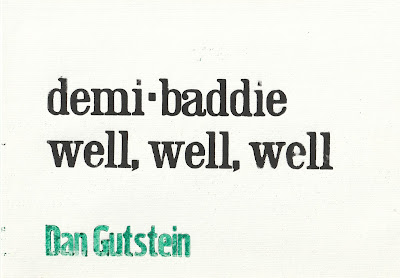It can be quite a blow when you
summon the courage to profess love, but the other individual does not reciprocate.
They have said as much (“ouch!”) or maybe they have slapped your wrist, taken
up with a rival, and moved to another area code. You have “made yourself
vulnerable” by saying “I love you” and all for what? Crickets. Or worse.
This has likely happened to everyone at some point. So, how can you achieve
comeuppance? Well, with some music, of course.
Jiminy Cricket but you’re good people, are you not? To
boot, you like to have high times. It’s not like you to moon over these unjust
weights. You want some guitar to be laid down. Some saxophone. Some keys. If you’re
gonna be miserable, “ffs,” then you’re gonna do a little jumping, a little
shaking. And lucky for us. Not only do a few musicians understand this selfsame
plight, but they have gone into the studio—and sang about it! Swimmingly
so.
Thus, we turn to a couple of
nearly-forgotten 45s, both A-sides, both from 1964, both soulful, to help us
navigate these sticky situations. Although each record bears the title “You
Don’t Love Me” they are indeed different songs, with one recorded in Memphis
and one recorded in Los Angeles. We begin with Memphis singer Tommy Raye (above
and above), who cut only one record in his short career. Neither projected
optimism. The title of his B-side? “Don’t Let Me Be the Last to Know.” (Ouch.)
From the very beginning, Raye knows that he’s
not loved. His baby has left him and he’s got no place to go. If you’re
recognizing “a familiar hand on the wheel” then you would be correct. The
uncredited Elias McDaniel aka Bo Diddley shines through as one of two co-composers.
As such, the guitar and keys drive hard. Meanwhile, Raye offers to get on his
knees and pray, if this would somehow alter the cold treatment by the gal he so
dearly cherishes. “Uh uh uhhh,” he sings. “Mm mm mmmm.” Kind of like “no” and “yes”
simultaneously. Perhaps the outcome hangs in the balance. By kneeling in
reverence, Raye may be closer than he thinks to getting “another shot.” This certainly
represents one possible route forward.
Now play this!
Enter one Z.Z. Hill, who enjoyed
a much longer career in the music industry as a soul and blues singer. His
singles and albums charted preposterously well and according to some, he “resuscitated
the blues” in the 1980s. In his “You Don’t Love Me” song, an original, Hill
just wants to talk things over. As with Raye, he too acknowledges a lack of affection,
but, you will admit, not being loved was never so much fun. The horns blare and
the background vocals form a kind of “Greek chorus” so that Hill can emphasize
his position to the gal he admires. Yet Hill is onto something deeper. “You don’t
love me,” he declares. Then quickly adds, “We can get together. It won’t be
hard to do.” Of course. You don’t need love. For that. It’s an unexpected
suggestion that may well work, by appealing to a more primal instinct, or simply
through its shock value.
Devotees of this blog may recall a post from
some years ago, when we provided a comprehensive guide to “who makes the love” during
an amorous encounter. By “make the love,” we mean “a passionate kiss &
etcetera.” We pointed out then, and we maintain today, that it can be
surprising. One may think that they have made the love when, instead, they were
made love to. Things are not so “clear cut” in the multiple arenas of “love
making” and professing your love. [“btw” Are you a Professor of Love?]
Okay, so kneel down and pray or raise your eyebrows with an
unexpected proposal. If neither works, then we suggest that you clear some
space, cue up these songs, raise the volume, and press “play.” Once the bodies
start moving, well, we believe that they may happily and tenderly collide.
Discographic Information
Tommy Raye. “You Don’t Love Me”
A-side b/w “Don’t Let Me Be the Last to Know” B-side. Pen Records 45-2PN-351.
Memphis, Tennessee (1964.) Tommy Raye (vocals.) Remainder of musicians unknown.
Compositional credit: Willie Cobbs and unlisted Elias McDaniel (aka Bo
Diddley.)
Z.Z. Hill. “You Don’t Love Me”
A-side b/w “If I Could Do It All Over” B-side. Kent Records K 404x45. Los
Angeles (1964.) Z.Z. Hill (vocals.) Remainder of musicians are unknown but may
have included Maxwell Davis (saxophone). Compositional credit: Z.Z. Hill.















